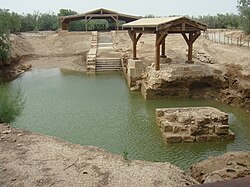| Al-Maghtas (Bethany Beyond the Jordan) | |
|---|---|
| Native name المغطس (Arabic) | |
 Excavation of baptism site | |
| Location | Balqa Governorate, Jordan |
| Coordinates | 31°50′14″N 35°33′01″E / 31.83722°N 35.55028°E |
| Website | www |
| Official name | Baptism Site "Bethany Beyond the Jordan" (Al-Maghtas) |
| Criteria | Cultural: (iii)(vi) |
| Reference | 1446 |
| Inscription | 2015 (39th Session) |
| Area | 294.155 ha (1.13574 sq mi) |
| Buffer zone | 957.178 ha (3.69568 sq mi) |
Al-Maghtas (Arabic: المغطس, meaning 'baptism' or 'immersion'), officially known as Baptism Site "Bethany Beyond the Jordan", is an archaeological World Heritage Site in Jordan, on the east bank of the Jordan River, reputed to be the original location of the Baptism of Jesus by John the Baptist and venerated as such since at least the Byzantine period.[1] The place has also been referred to as Bethabara (Hebrew: בית עברה) and historically Bethany (Beyond the Jordan).[2]
Al-Maghtas includes two principal archaeological areas: the remnants of a monastery on a mound known as Jabal Mar-Elias (Elijah's Hill) and an area close to the river with remains of churches, baptism ponds and pilgrim and hermit dwellings.[3] The two areas are connected by a stream called Wadi Kharrar.[4][5]
The strategic location between Jerusalem and the King's Highway is already evident from the Book of Joshua report about the Israelites crossing the Jordan there. Jabal Mar-Elias is traditionally identified as the site of the ascension of the prophet Elijah to heaven.[6] The complete area was abandoned after the 1967 Six-Day War, when both banks of the Jordan became part of the frontline. The area was heavily mined then.[7]
After the signing of the Israel–Jordan peace treaty in 1994, de-mining of the area soon took place at the initiative of Jordanian Prince Ghazi.[8] The site has since then seen several archaeological digs, visits by three Popes (John Paul II, Benedict XVI, and Francis) and by many heads of state,[9] and attracts tourists and pilgrimage activity.[10] In 2015, the site was designated as a World Heritage Site by UNESCO, excluding the western side of the river. Approximately 81,000 people visited the site in 2016, mostly European, American, and Arab tourists.[11] Thousands flock to the site on January 6 to mark Epiphany.[10]
- ^ Cite error: The named reference
Evaluationwas invoked but never defined (see the help page). - ^ Cite error: The named reference
SeeHLwas invoked but never defined (see the help page). - ^ "Baptism Site "Bethany Beyond the Jordan" (Al-Maghtas) – UNESCO World Heritage Centre". UNESCO. Archived from the original on 19 January 2017. Retrieved 6 December 2015.
- ^ Tharoor, Ishaan (July 13, 2015). "U.N. backs Jordan's claim on site where Jesus was baptized". The Washington Post. Archived from the original on July 10, 2018. Retrieved December 24, 2015.
- ^ "The Discovery of Bethany Beyond the Jordan River (Wadi Al-Kharrar)". Journals.ju.edu.jo. Archived from the original on 2015-04-02. Retrieved 2015-04-29.
- ^ Rosemarie Noack (22 December 1999). "Wo Johannes taufte". Die Zeit. Archived from the original on 2016-02-20. Retrieved 2015-12-09.
- ^ "UNESCO backs Jordan River as Jesus' baptism site". Al Arabiya News. Dubai, United Arab Emirates. Associated Press. 13 July 2015. Archived from the original on 31 December 2018. Retrieved 24 December 2015.
- ^ "'Adding Baptism Site to World Heritage List grants it further int'l recognition'". Jordan Times. Archived from the original on 2017-10-12. Retrieved 2018-04-18.
- ^ "All World Leaders – Baptism Site". www.baptismsite.com. Archived from the original on 2022-09-29. Retrieved 2022-07-30.
- ^ a b "Catholics celebrate Epiphany, coexistence of faiths at Baptism Site". Jordan Times. 9 January 2016. Archived from the original on 2018-07-18. Retrieved 2018-04-18.
- ^ "الفرجات: 81 ألفا زاروا المغطس العام الماضي". Al Ghad (in Arabic). 2 January 2017. Archived from the original on 3 January 2017. Retrieved 7 January 2017.
